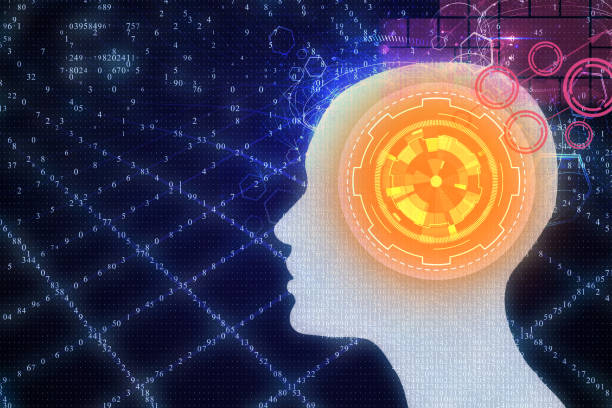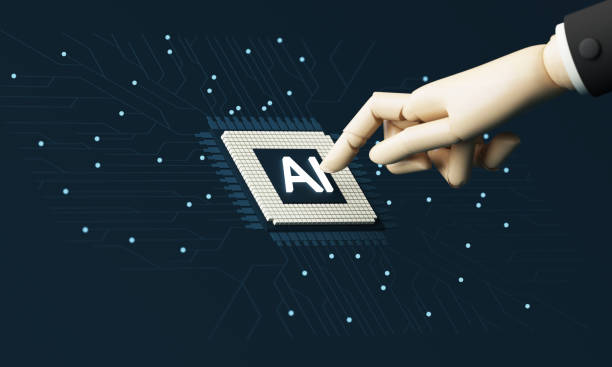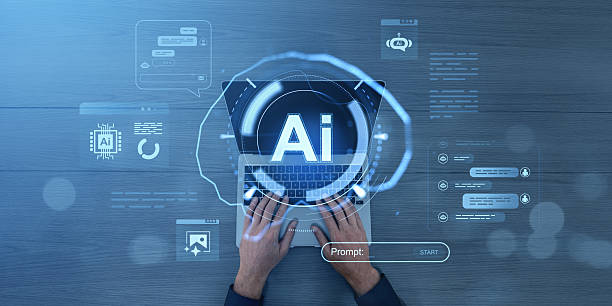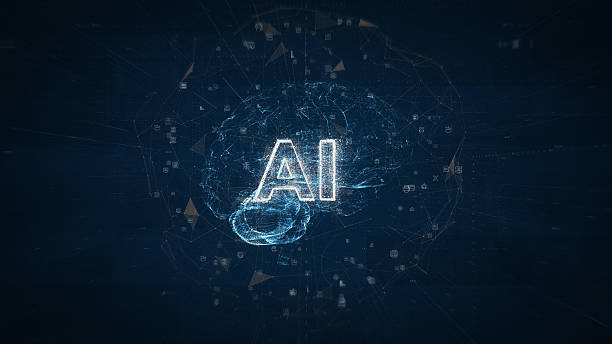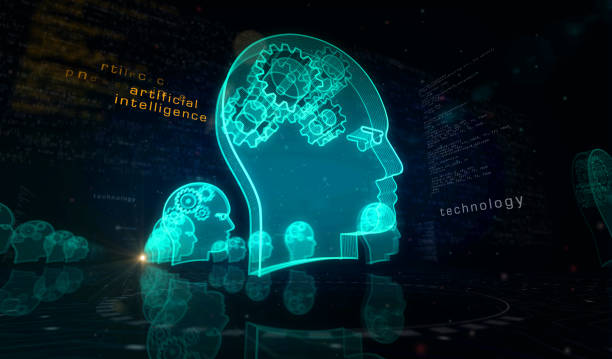What is Artificial Intelligence and What are its Applications?
Artificial Intelligence (AI) is a branch of #computer_science that deals with building machines capable of performing tasks that typically require human intelligence.
These tasks include learning, reasoning, problem-solving, perception (such as face and speech recognition), and natural language.
The main goal of Artificial Intelligence is to create systems that can think and make decisions independently.
The applications of Artificial Intelligence are very broad and have penetrated almost all industries and aspects of modern life.
These applications include:
- Self-driving cars
- Virtual assistants like Siri and Alexa
- Fraud detection in financial transactions
- Stock market trend prediction
- Disease detection from medical images
- Machine translation of languages
In fact, wherever there is a need for analyzing large data, making quick decisions, or performing repetitive and laborious tasks, Artificial Intelligence can provide effective solutions. Artificial Intelligence is transforming our world.
Do you dream of a thriving online store but don’t know where to start?
Rasaweb is your comprehensive solution for e-commerce website design.
✅ Attractive and user-friendly design
✅ Increased sales and revenue⚡ Get a free consultation
History and Evolution of Artificial Intelligence
The history of Artificial Intelligence dates back to the mid-20th century, when researchers began exploring the possibility of building machines that could think.
The Dartmouth Conference in 1956 is often regarded as the official starting point of this field.
In the early decades, the focus was on solving logical problems and games.
Programs like the “General Problem Solver” attempted to mimic human problem-solving methods.
In the 1980s and 1990s, we witnessed the emergence of expert systems that encoded the knowledge of specialists in specific fields (such as medicine and engineering).
These systems could help users make complex decisions.
However, the limitations of these systems (especially the difficulty in updating and maintaining knowledge) led to their decline in popularity.
Click here to preview your posts with PRO themes ››
The main renaissance of Artificial Intelligence began in the early 2000s with significant advances in machine learning, especially Deep Learning.
Deep learning allows artificial neural networks to learn patterns from vast amounts of data and perform tasks such as image and speech recognition with high accuracy.
Today, deep learning is the driving force behind many Artificial Intelligence applications.
Machine Learning and Deep Learning: Key Concepts
Machine Learning is a subset of Artificial Intelligence that allows machines to learn from data without explicit programming.
Machine learning algorithms extract patterns from data and use these patterns for prediction or decision-making.
There are different types of machine learning algorithms, including:
- Supervised Learning where the algorithm is trained using labeled data.
- Unsupervised Learning where the algorithm tries to find patterns in unlabeled data.
- Reinforcement Learning where the algorithm learns by trial and error and receiving rewards and penalties.
Deep learning is a type of machine learning that uses artificial neural networks with many layers (so-called “deep”).
These networks are capable of learning complex features from data and perform very well in tasks such as image recognition, speech, and machine translation.
Popular architectures such as Convolutional Neural Networks and Recurrent Neural Networks are examples of deep neural networks.
| Learning Type | Description | Applications |
|---|---|---|
| Supervised Learning | Training using labeled data | Image recognition, text classification |
| Unsupervised Learning | Finding patterns in unlabeled data | Clustering, dimensionality reduction |
| Reinforcement Learning | Learning through trial and error | Games, robotics |
Natural Language Processing (NLP) and its Applications
Natural Language Processing (NLP) is a branch of Artificial Intelligence that enables machines to understand and generate human language.
This field includes various tasks:
- Sentiment Analysis Detecting the emotions present in the text
- Machine Translation Automatically translating text from one language to another
- Text Summarization Generating short summaries of long texts
- Question Answering Answering questions asked about a text
NLP is used in various applications.
For example, virtual assistants like Siri and Alexa use NLP to understand users’ voice commands and respond to them.
Search engines use NLP to improve search results and better understand users’ intent.
Companies use NLP to analyze customer feedback and identify potential problems.
Large Language Models (LLMs) such as GPT-3 and BERT have made significant advances in NLP.
By training on a vast amount of text data, these models are able to generate coherent texts and answer questions accurately.
LLMs are changing how we interact with machines and how information is produced and consumed.
Are you worried that your old company website will scare away new customers? Rasaweb solves this problem with a modern and efficient corporate website design.
✅ Increases your brand credibility.
✅ Helps attract targeted customers.
⚡ Contact Rasaweb for a free consultation!
Computer Vision and Image Recognition
Computer Vision is a branch of Artificial Intelligence that allows machines to “see” and understand images.
This field includes various tasks:
- Object Detection Identifying and locating objects in an image
- Face Detection Identifying the faces of people in an image
- Semantic Segmentation Assigning a semantic label to each pixel in an image
- 3D Reconstruction Creating 3D models of objects from images
Computer vision is used in various applications.
For example, self-driving cars use computer vision to detect obstacles and traffic signs.
Security systems use computer vision to recognize people’s faces and identify suspicious activities.
Medical images use computer vision to detect diseases and abnormalities.
Convolutional Neural Networks (CNNs) are the dominant architecture in computer vision.
CNNs are specifically designed for image processing and perform very well in tasks such as image recognition and object detection.
Transfer Learning is also a common technique in computer vision where a pre-trained model on a large dataset is used for a new task.
Robotics and Artificial Intelligence
Robotics is a field that deals with the design, construction, operation, and application of robots.
Robots are machines that can perform tasks automatically or remotely.
Artificial Intelligence plays an important role in robotics, as it allows robots to understand their environment, make decisions, and act.
Robots equipped with Artificial Intelligence can perform tasks such as:
- Autonomous Navigation Moving in complex environments without human guidance
- Motion Planning Finding optimal paths for performing tasks
- Object Manipulation Grabbing, moving, and using objects
- Human-Robot Interaction Communicating and cooperating with humans
Industrial robots, service robots, and explorer robots are examples of robots that use Artificial Intelligence.
Industrial robots are used on factory production lines to perform repetitive and precise tasks.
Service robots are used in hospitals, hotels, and restaurants to provide services to customers.
Explorer robots are used in dangerous and inaccessible environments (such as the deep sea and space) to collect information.
Challenges and Limitations of Artificial Intelligence
Despite significant advances in Artificial Intelligence, there are still many challenges and limitations.
One of the main challenges is the need for a huge amount of data to train Artificial Intelligence models.
Collecting and labeling this data can be costly and time-consuming.
Another challenge is the Explainability of Artificial Intelligence models.
Many complex models (such as deep neural networks) act like black boxes and it is difficult to understand why a model has made a particular decision.
This can be problematic in applications where trust and transparency are required.
In addition, Artificial Intelligence still struggles to mimic human intelligence in some areas (such as reasoning, creativity, and intuitive understanding).
There are also ethical concerns about bias in data and algorithms, job losses due to automation, and the use of Artificial Intelligence in automatic weapons.
To address these challenges, there is a need for further research and development, the creation of ethical frameworks, and the training of the workforce for new skills.
| Challenge | Description |
|---|---|
| Need for large data | Training models requires a huge amount of data |
| Explainability | It is difficult to understand the reason for the decisions of the models |
| Bias | Potential for bias in data and algorithms |
The Future of Artificial Intelligence
The future of Artificial Intelligence is bright and full of potential.
It is expected that Artificial Intelligence will increasingly penetrate our daily lives and change how we work, live, and interact with each other.
Advances in machine learning, computer vision, natural language processing, and robotics will create new and innovative applications.
Self-driving cars, smarter virtual assistants, personalized healthcare services, and automated factories are just a few examples of these applications.
However, it is important to pay attention to the potential challenges and risks of Artificial Intelligence and take the necessary measures to reduce them.
The development of Artificial Intelligence should be done responsibly and taking into account ethical and social values.
There is a need for cooperation between researchers, policymakers, and the general public to shape the future of Artificial Intelligence in a way that is beneficial to all.
Are you tired of losing customers due to a poor e-commerce website design? With Rasaweb, solve this problem forever!
✅ Increase sales and visitor-to-customer conversion rates
✅ Smooth and attractive user experience for your customers⚡ Get a free consultation
The Impact of Artificial Intelligence on Various Industries
Artificial Intelligence has had a profound impact on various industries.
In healthcare, Artificial Intelligence plays a role in diagnosing diseases, developing new drugs, and providing personalized care.
In finance, Artificial Intelligence is used in fraud detection, risk management, and providing investment advisory services.
In manufacturing, Artificial Intelligence plays a role in automating production lines, improving product quality, and reducing costs.
In transportation, Artificial Intelligence is used in the development of self-driving cars, optimizing routes, and reducing accidents.
In education, Artificial Intelligence plays a role in providing personalized education, assessing student performance, and developing new educational tools.
In general, Artificial Intelligence allows companies to increase their productivity, reduce their costs, provide better products and services, and make better decisions.
Companies that effectively utilize Artificial Intelligence can gain a significant competitive advantage over their competitors.
How to Learn Artificial Intelligence?
Learning Artificial Intelligence requires a combination of theoretical knowledge and practical skills.
To get started, you can familiarize yourself with the basic concepts of mathematics (such as linear algebra and statistics), programming (especially Python), and machine learning.
There are many online resources for learning these concepts, including online courses, books, and scientific articles.
After familiarizing yourself with the basic concepts, you can start working on practical projects.
These projects can include building a simple image recognition system, training a small language model, or designing a small robot.
Working on projects will help you apply theoretical concepts in practice and strengthen your skills.
In addition, attending conferences, workshops, and online Artificial Intelligence communities can help you stay up-to-date with the latest advances in this field and connect with other Artificial Intelligence professionals.
Frequently Asked Questions
| Question | Answer |
|---|---|
| What is Artificial Intelligence? | It is the simulation of human intelligence in machines programmed to think like humans and mimic their actions. |
| What are the main branches of Artificial Intelligence? | These include machine learning, deep learning, natural language processing, computer vision, and robotics. |
| What is Machine Learning? | It is a branch of Artificial Intelligence that focuses on enabling systems to learn from data and identify patterns without explicit programming. |
| Mention examples of Artificial Intelligence applications in our daily lives. | Voice assistants (such as Siri and Alexa), recommendation systems on Netflix and Amazon, self-driving cars, and facial recognition software. |
| What is Deep Learning? | It is a subset of machine learning that uses multiple layers (deep) of artificial neural networks to process large amounts of data. |
| What is Natural Language Processing (NLP)? | It is a branch of Artificial Intelligence that focuses on enabling computers to understand, interpret, and generate human language. |
| What are some ethical concerns related to Artificial Intelligence? | These include bias in data, privacy, job losses, and responsibility in case of errors. |
| What are the main benefits of Artificial Intelligence? | Increased efficiency, improved decision-making, automation of repetitive tasks, and discovery of complex patterns in data. |
| How is Artificial Intelligence used in healthcare? | In diagnosing diseases, discovering drugs, analyzing medical images, and personalizing patient care. |
| How do you see the future of Artificial Intelligence? | It is expected to continue developing at a rapid pace, affecting all aspects of human life, from industry to education and entertainment. |
And other services of Rasa Web Advertising Agency in the field of advertising
Intelligent SEO: An effective tool to increase sales by using real data.
Intelligent Website Development: A combination of creativity and technology to manage campaigns through SEO-driven content strategy.
Intelligent Google Ads: A fast and efficient solution for user interaction with a focus on proprietary programming.
Intelligent Digital Advertising: Professional optimization for user interaction using attractive user interface design.
Intelligent Website Development: An exclusive service to grow click-through rates based on marketing automation.
And over a hundred other services in the field of internet advertising, advertising consulting, and organizational solutions
Internet Advertising | Advertising Strategy | Advertorial
Sources
What is Artificial Intelligence?
,What is Artificial Intelligence and What are its Applications? (+ Introduction to Types of Artificial Intelligence)
,What is Artificial Intelligence (AI)? – Technology Rito
,What is Artificial Intelligence?
? If you are looking to get seen and dramatically grow your business in the digital space, Rasaweb Digital Marketing Agency with expertise in modern user interface website design, SEO, and comprehensive online marketing strategies, is your reliable partner.
📍 Tehran, Mirdamad Street, next to the Central Bank, South Kazerun Alley, Ramin Alley No. 6

